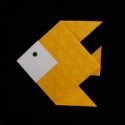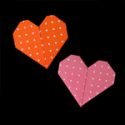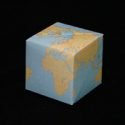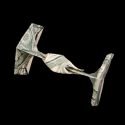3D Origami
by Boutique-sha Staff

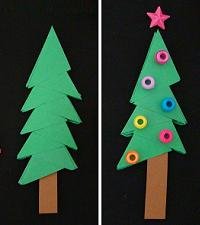
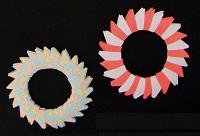
The book then progresses to more complex models such as:
– Turtle (30-40 units)
– Watermelon (215 units)
– Sunflower (100 units)
– Kingfisher (55 units), and
– Soaring Crane (85 units)
These have more volume and are certainly more interesting; but they are still considered “horizontal assemblies” since they involve only one row of triangular units.

– a Stand (12 units)
– a Toothpick Holder (70 units)
– a Lemon (100 units), and
– a Hat (170 units)
Large 3D models require 300+ triangular units. These are not particularly difficult to make, but require much time and patience.
– a Temari Ball (75 units)
– a Swan (350-450 units)
– a Pineapple (375 units), and
– little creatures like this Penguin (350 units)


Organization of 3D Origami Book
This book is organized in a somewhat cryptic manner. For the most part, the first half of the book has color photos of the completed models, and the second half of the book has instructions on how to make the models. Though, it is not clear-cut since there are some instructions in the color photo section.
Instructions are in the form of:
– black & white photos,
– text, and
– symbols in the form of filled and empty triangles: ▲ ▼ Δ.
Using all three kinds of information, you are sure to find success!
Summary
In summary, this is a very good book with a total of 38 models which will keep you busy for many hours. However, to be able to accomplish these projects, you must have the desire and patience to fold many small triangular units and to painstakingly assemble them with the help of somewhat cryptic (but surprisingly complete) instructions.
A determined 10 year old can make most of these projects. Younger children can accomplish the 2D projects (tree, rings) but will need help in the larger projects.
If you love this book, be sure to buy the two subsequent books: “More 3D Origami” and “More and More 3D Origami”
- Buy 3D Origami here
- free 3D origami diagrams
- see more book reviews
- go to Home Page
- go to Site Map
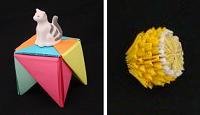
-
Books with Easy Origami
- Easy Origami: over 30 simple projects by John Montroll
- Origami Fun Kit for Beginners by John Montroll
- My First Origami Kit by Joel Stern
- Easy Origami: A Step-by-Step Guide for Kids by C Alexander & M Meinking
- Fun With Easy Origami (Dover Origami Papercraft)
- Origami: A Step-by-Step Introduction to the Art of Paper Folding by T Cook & S Henry
- Easy Origami For Kids Book Traditional Japanese Folding Papers Overs 20 Projects by J Wish
- Easy Origami for Kids: Over 40 Simple Origami Projects by O Brooks
Please Help
Please help by reporting broken links so that we can fix them. One easy message from you can save us hours and hours of clicking. Thanks!
-
More Origami Diagrams and Instructions…
-
These free origami instructions are made available to you by the paper folding community at large. If you have a diagram you would like to share, or if your diagram is listed here and you wish to have it removed, please Contact Us. Diagrams are intended for personal use. Copyright of the models lie with the origami creators and designers. Please contact the designer and/or creator directly for non-private usage of a model and/or artwork.









